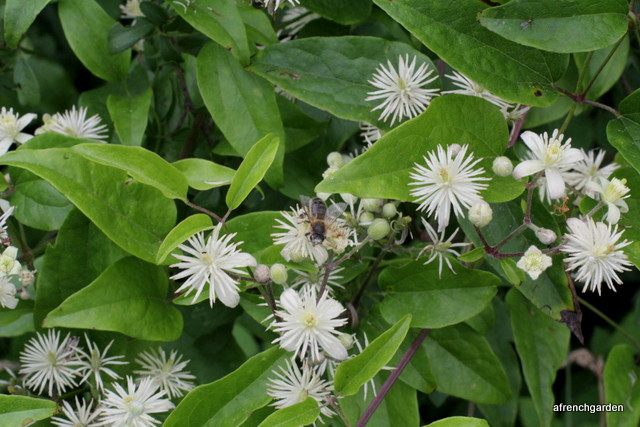Last week I was very worried about the bees. We are new to beekeeping and we visit the girls everyday (often more than once) just to see how they are getting on as you can learn a lot by just watching them.
However, I noticed a strange odour around the beehives and Kourosh confirmed that he could smell it too. When it lasted more than a day or too I began to recall bee diseases that had unpleasant odours attached to them. However, the bees were doing so well and the odour, although unusual, was not unpleasant. In fact, it smelt familiar but I could not place it.
It was not until we went for a walk into the woods that I traced the source of the perfume (?). We had been watching the Sweet Chestnuts (Castanea sativa) throw out the unripe catkins and knew that the flowering was imminent but we had never suspected that the bees could bring so much pollen back that we would be able to smell it in front of the hives.
The male flowers produce long stamens and the quantity of pollen produced by the tree is enormous. One method of testing to see what type of honey that the bees produce is to examine the pollen grains trapped inside the honey. However, the quantity of pollen produced by the sweet chestnut can complicate the analysis and I have read that some honeys in France which are 100% Latifolia (the commercially grown lavender for perfume, essential oils etc.) and, therefore, monofloral could containe 80% of sweet chestnut pollen!
We are lucky to be surrounded by woods containing Sweet Chestnut trees so the bees are happy just now and we are happy to collect the chestnuts in the autumn.
The female flowers which are tiny and insignificant in comparison to the stamens of the male flower. After receiving comments provoked by the Facebook page of the BBKA I need to clarify where the nectaries of the Sweet Chestnut trees are situated. I have found a paper in which one of the main criteria was to study the morphology of Sweet Chestnut flowers. ( Flower morphology of Castanea sativa Mill From Bulgaria and characteristics of unifloral chestnut honey ( Comptes rendus de l’Académie bulgare des sciences: sciences mathématiques et naturelles · January 2013.Juliana Atanassova, Spassimir Tonkov (Submitted by Academician V. Golemansky on April 19, 2013)) This paper quoted, as a reference, Farkas A., E. Zajacz. ́ Eur. J. Plant Sci. Biotech., 1, 2007, No 2, 125–148. but I was unable to find this on the internet but it appears another quirk of the sweet chestnut that this mainly wind pollinated tree produces nectar from nectaries situated on the male flowers which also produce pollen, although at different times to avoid cross-pollination.
Looking closer at the flowers you can see the formation of the prickly green cover that protects the mature chestnuts.
The form of the female flowers remind me of the hazel nut flowers but perhaps the hazel flowers are more stunning with their surprisingly red colour.
What did intrigue me was that in spite of the abundance of the chestnut nectar and pollen the bees were still visiting the brambles (Rubus fruticosus) that were growing in the undergrowth beneath the trees . This will alter the flavour and constituency of any honey produced if the bees mix the nectar of different plants and I am sure ours will.
It was not only the honey bees.
But other pollinators were attracted to the brambles.
I saw honey bees on the Old Man’s Beard (Clematis vitalba) despite the feast of plenty overhead. An abundant source of nectar and pollen does not stop the bees visiting the other sources.
Checking out for bees and nectar sources under the trees I noticed this lovely Wild Carrot (Daucus carota) or Queen Anne’s Lace with its sole red floweret in the centre of the bloom. This has nothing to do with Sweet Chestnuts and bees but I just thought it was so lovely.
So the odour has disappeared from the hives and it will be something we will expect to reappear next year when the Sweet Chestnut trees flower. Perhaps we will be less nervous and more confident then. Until then Kourosh has fitted all the supers with clear plastic covers so that we can have a peek at the bees filling up the frames without disturbing them.


















